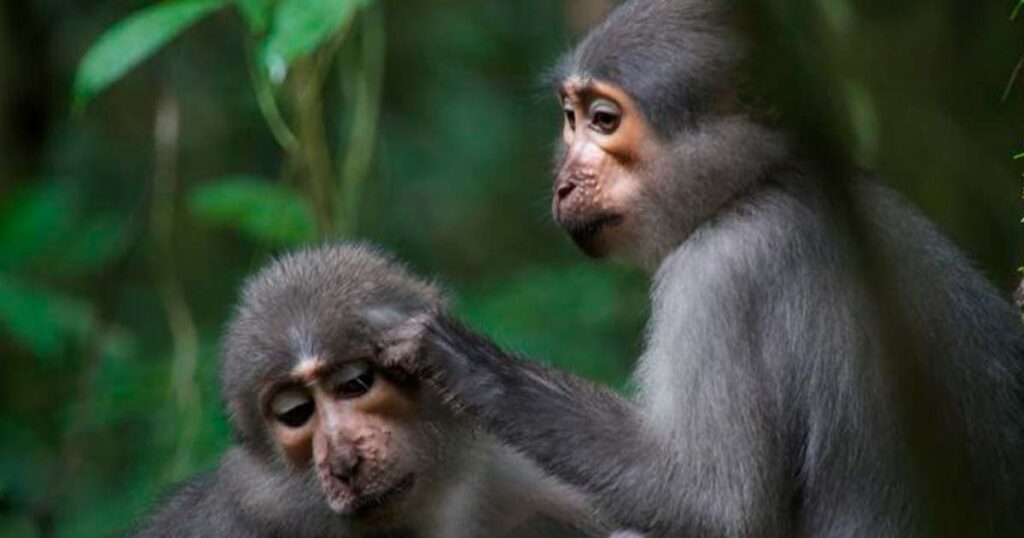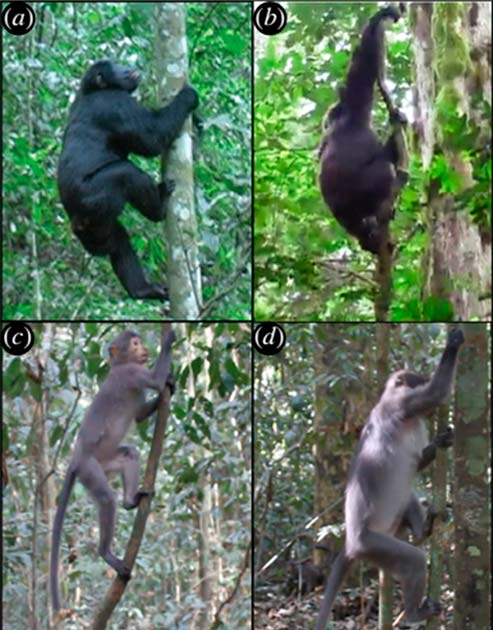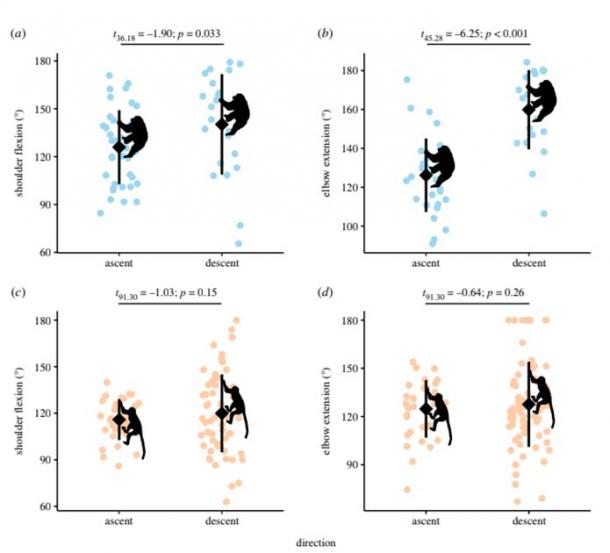
One of the watershed moments in the evolution of ‘human’ or ‘ Homo’ history is when the first hominids descended from the trees to achieve bipedal locomotion ( Homo erectus), causing a separation in lineage from our four-legged ape ancestors. To add to this commonly circulated knowledge, a new study has found that the rotation of shoulders and extension of elbows may have originally developed as a natural safety mechanism, to allow our primate ancestors to downclimb from trees without risking their lives!
For example, the ability for humans to reach high shelves or engage in activities like throwing a ball with friends, involves the rotation of shoulders and extension of elbows. Researchers from Dartmouth have published their findings in the newest edition of the Royal Society Open Science journal.
Downclimbing: An Important Evolutionary Distinction
The study authors propose that apes and early humans evolved flexible shoulders and elbows to facilitate a controlled descent from trees, counteracting the pull of gravity on their heavier bodies. As early humans transitioned from forests to grassy savannas, these adaptable limb structures proved crucial for tasks such as gathering food and utilizing tools for hunting and defense.
Using sports analysis and statistical software to compare video footage and stills of chimpanzees and small monkeys called mangabeys, out in their habitats in the wild, the scientists observed that both chimpanzees and mangabeys displayed similar tree-climbing techniques. This included shoulders and elbows typically held close to their bodies.
When descending, on the other hand, chimpanzees extended their arms above their heads to grasp branches, resembling a person descending a ladder, compensating for their increased weight as they descended with their bottom leading.

Figure 1. Bouts of vertical climbing in chimpanzees (a, b) and sooty mangabeys (c, d). Maximum angles of shoulder flexion and elbow extension were greater during downclimbs (b, d) compared to upclimbs (a, c), and the magnitudes of these differences were greatest among chimpanzees. Panels (a) and (b) taken by J.M.D and panels (c) and (d) taken by L.D.F. (Luke Fannin, Dartmouth College/Royal Society Open Science)
“Our study broaches the idea of downclimbing as an undervalued, yet incredibly important factor in the diverging anatomical differences between monkeys and apes that would eventually manifest in humans. Downclimbing represented such a significant physical challenge given the size of apes and early humans that their morphology would have responded through natural selection because of the risk of falls,” explained study first author Luke Fannin, who is a graduate student in Dartmouth’s Ecology, Evolution, Environment, and Society program.
He emphasized that these findings represent one of the earliest insights into the significance of “down climbing” in the evolutionary development of apes and early humans, who share a closer genetic relationship with each other than with monkeys.
Into the Wild: Understanding the Principles of Natural Selection
While prior research has predominantly focused on chimpanzees ascending and maneuvering in controlled environments, the extensive footage captured in the wild allowed researchers to examine how these animals adapted their bodies to the challenges of descending from trees.
“Our field has thought about apes climbing up trees for a long time—what was essentially absent from the literature was any focus on them getting out of a tree. We’ve been ignoring the second half of this behavior. The first apes evolved 20 million years ago in the kind of dispersed forests where they would go up a tree to get their food, then come back down to move on to the next tree,” explained study co-author Jeremy DeSilva, professor and chair of anthropology at Dartmouth.
DeSilva further explained that with the weight and guile that big apes carry, they could not afford to fall, as it would only result in death or grievous hurt. By the larger principles of nature selection, those anatomies that could descend safely would be favored. The inheritable trait of flexible shoulders and elbows could have provided early humans, like the Australopithecus, with the ability to climb trees for safety during the night and safely descend during daylight.
As Homo erectus learned to utilize fire for protection against nighttime predators, human physiology evolved further. This evolution included the development of broader shoulders capable of a 90-degree angle, combined with the pre-existing features of free-moving shoulders and elbows. These adaptations collectively made our ancestors proficient at spear throwing, a skill that set them apart from apes, which lack the precision needed for accurate projectile throwing – another important evolutionary distinction.
Anatomical Structure of Arms: Chimpanzee vs. the Mangabey and the Role of Gravity
The researchers also delved into the anatomical structure of chimpanzee and mangabey arms by examining skeletal collections at Harvard University and The Ohio State University – essentially a huge ape, versus small. Interestingly, chimpanzees, much like humans, possess a shallow ball-and-socket shoulder joint, which, while more susceptible to dislocation, affords a broader range of movement. Chimpanzees can also fully extend their arms, a feature facilitated by the shortened bone just behind the elbow, known as the olecranon process, according to the study.
On the other hand, mangabeys and other monkeys exhibit a build more reminiscent of quadrupedal animals like cats and dogs. They possess deep pear-shaped shoulder sockets and elbows characterized by a protruding olecranon process, forming a joint that resembles the letter L. While these joint structures offer increased stability, they come at the cost of limited flexibility and a narrower range of motion.
The researchers’ analysis unveiled that chimpanzees exhibited a shoulder angle 14 degrees greater during descent compared to ascent, and their elbow extended outward by 34 degrees more when descending from a tree as opposed to climbing up. In contrast, mangabeys demonstrated only minor differences, with shoulder and elbow angles varying by 4 degrees or less between ascending and descending while climbing trees.

Study shows the effect of vertical climbing direction on shoulder flexion and elbow extension in chimpanzees (a, b) and sooty mangabeys (c, d). Chimpanzees (light blue) exhibited significantly higher degrees of average shoulder flexion (a) and elbow extension (b) during vertical descent compared to vertical ascent. (Luke Fannin, Dartmouth College/ Royal Society Open Science)
Through the process of descent, one doesn’t just resist the pull of gravity, but is simultaneously decelerating. Mary Joy, a co-author who led the study alongside Fannin for her undergraduate thesis and graduated from Dartmouth in 2021, mentioned that while reviewing videos of chimps filmed by DeSilva, she noticed a disparity in how the animals descended from trees compared to how they ascended them.
She described it as a somewhat controlled fall, with chimps moving erratically and crashing down. Ultimately, they concluded that the way chimps descend a tree is likely related to their weight. Greater momentum potentially expends less energy, and it’s a more energy-efficient method. The speed and abandon with which chimps climb down from trees may be more energy-efficient for heavier primates, despite it not being an intuitively obvious choice.
“It’s the template that we came from—going down was probably far more of a challenge for our early ancestors, too. Even once humans became upright, the ability to ascend, then descend, a tree would’ve been incredibly useful for safety and nourishment, which is the name of the game when it comes to survival. We’re modified, but the hallmarks of our ape ancestry remain in our modern skeletons,” concluded Fannin.